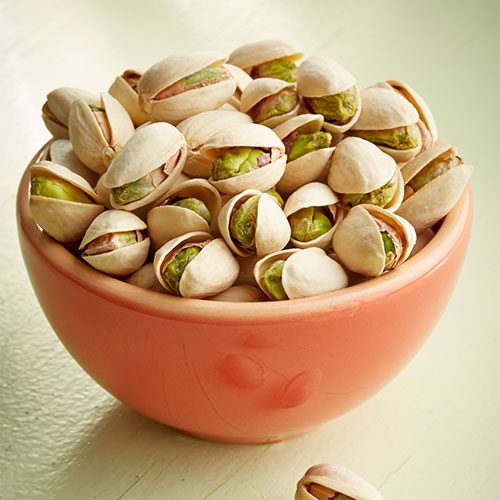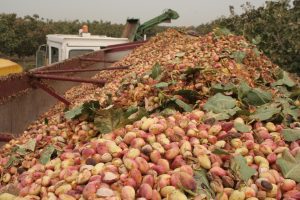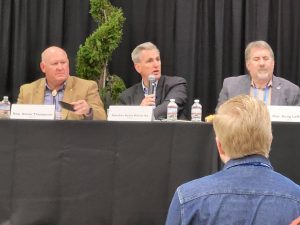
Tree nuts and other specialty crops have long been overshadowed in farm bill considerations by big program commodities like corn, wheat and soybeans.
But, as the 2023 farm bill takes shape, specialty crop leaders are making their voices heard. They were among the more than 30 speakers from diverse agricultural and food organizations who addressed the House Committee on Agriculture’s farm bill listening session at World Ag Expo on February 14 in Tulare, Calif. Across the board, they sought understanding and support for their unique challenges and opportunities.
On the listening end of the 10-member panel were House Agriculture Committee Chairman Glenn “GT” Thompson, a Republican from Pennsylvania, and Speaker of the House Kevin McCarthy, whose California congressional district covers parts of Kern, Fresno, Tulare and Kings counties. The panel also included House Ag Committee members from California: David Valadao (R), Jim Costa (D), Doug LaMalfa (R), John Duarte (R) and Salud Carbajal (D). Also involved from the House Committee on Agriculture were Republicans David Rouzer from North Carolina and John Rose of Tennessee. Although not on the House Ag Committee, Rep. Jimmy Panetta (D), who serves California’s 19th District, also joined the listening panel.
Among those addressing the “farm team” legislators was Richard Matoian, president of American Pistachio Growers (APG). A non-profit trade association, APG represents more than 800 growers in California, Arizona and New Mexico in raising awareness of the benefits of the U.S.-grown nuts.

Matoian’s comments were not only endorsed by his board of directors. APG is also a member of the Specialty Crop Farm Bill Alliance as were many groups represented at the World Ag Expo gathering. The alliance is a national coalition of more than 200 organizations representing growers of fruits, vegetables, tree nuts, nursery plants and other products. They have agreed on a package of farm bill proposals to be delivered in unison for greater emphasis to policymakers. Matoian was helping do that in Tulare as he did below for West Coast Nut.
The 2018 farm bill expires September 30, 2023, with the new one expected to start October 1. The bipartisan panel in Tulare vowed to get the new farm bill out on time.
“There’s a long way between now and the finish line of voting for the farm bill,” Matoian says. “We need to make sure that, at every opportunity, we make our voice heard.”
Q. You led your comments to the farm bill panel with pistachio industry facts and figures. Can you recap those?
Pistachios have grown significantly since the year 2000. California has gone from roughly 100,000 bearing acres to about 465,000 bearing acres. The growth percentage has significantly outpaced that of almonds and walnuts.
The other thing I mentioned is that four congressional members at the hearing (Costa, Valadao, Duarte and McCarthy) represent over 90% of the current bearing acreage of pistachios in California. There’s some additional acreage going on in Congressman LaMalfa’s district, north of Sacramento. Today, 99% of the nation’s pistachio production is in California. Of that, 97% is concentrated in the central and southern San Joaquin Valley.

Q. Your first request of the farm bill panel addressed water and drought. What were you hoping those members can do?
To whatever extent the ag committee can influence policy, we need their immediate and urgent attention. What’s affecting us most are these Endangered Species Act biological opinions. They are what cause water to flow through the Delta and out to the ocean to save the various species. We believe those biological opinions have more flexibility than what they say or suggest. We want that flexibility so, when we have all this water flow, some of it can be diverted for agricultural use. The other thing would be drought declarations that could be made to provide low-interest loans to producers or provide funding for infrastructure building.
Q. You also asked for a funding increase for the navel orangeworm sterile-fly program. Can you explain?
Currently, there is about $10.5 million from the federal government to run a sterile fly facility in Phoenix. They’re bringing sterile navel orangeworm flies into California and spreading them over about 4,000 acres of pistachios and almonds to see what effect they have on the native wild population. Our goal is to reduce that population so we can reduce pesticide use. The program is in its fourth year. We need more funds to get more researchers involved to determine if the project is actually having success.
Q. The Market Access Program, or MAP, was also on your list. What are you asking for?
Between 60% and 70% of U.S. pistachio, almond and walnut production is exported. MAP provides federal dollars, and we have to provide matching dollars, to promote our product generically in a foreign country. The problem with the program is that it’s been funded at $200 million for two decades. More than 80 organizations participate in MAP. We’re all competing with each other for this same pool of $200 million. We believe that dollar amount needs to be increased to at least $400 million.
Q. You also addressed Section 32 purchases, the government purchases of commodities.
It’s not a single block of cheese that people get through this program. There are many other commodities that are part of it. The government has done a Fresh Box Program. During COVID-19, they had Whole Meal Programs. Each box of food could not exceed a certain dollar amount. Commodities like pistachios couldn’t participate because our price point was very high. In recent years, almonds, walnuts, pistachios, prunes, table grapes, dried cherries and raisins have all been a part of this program. When there is an oversupply of our product, like this last year when we had our largest-ever carryovers of almonds, pistachios and walnuts, we want the government to purchase it. The food is given to programs geared to needy families, senior citizen, homeless shelters and other outlets. We want to ensure the program continues.

Q. Your last request involved federal crop insurance. What do you want farm bill policymakers to keep in mind?
Crop insurance is important, and we want to make sure it gets continued. Very few people know that pistachios were one of last permanent crops to gain federal crop insurance. Pistachios did not have a federal crop insurance program until 2012. It’s been a good program, although not every grower participates. We want our legislators to know how important the program is to our industry and the need to keep this USDA-backed program in place.
Q. Can you clarify how the Adjusted Gross Income and payment limits apply to government programs?
Think about the Coronavirus Food Assistance Program and the Ag Trade Mitigation Program. If you had an AGI level of $900,000 or more, you couldn’t participate in those programs. There is also the payment limitation of $250,000. For some commodities, that seems like a lot of money. But for some specialty crops, the payment limit of $250,000 is a drop in the bucket. We’re not saying to remove the cap. We’re saying it needs to be adjusted upwards to reflect the fact that specialty crops are, in fact, a higher-income crop on a per-acre basis than, say, corn or soybeans.
Q. What’s the next step for these farm bill recommendations?
The Specialty Crop Farm Bill Alliance has a legislative committee that, at any and every opportunity, provides the information to policymakers so they know what our position is. A consistent message from all alliance members is important.










